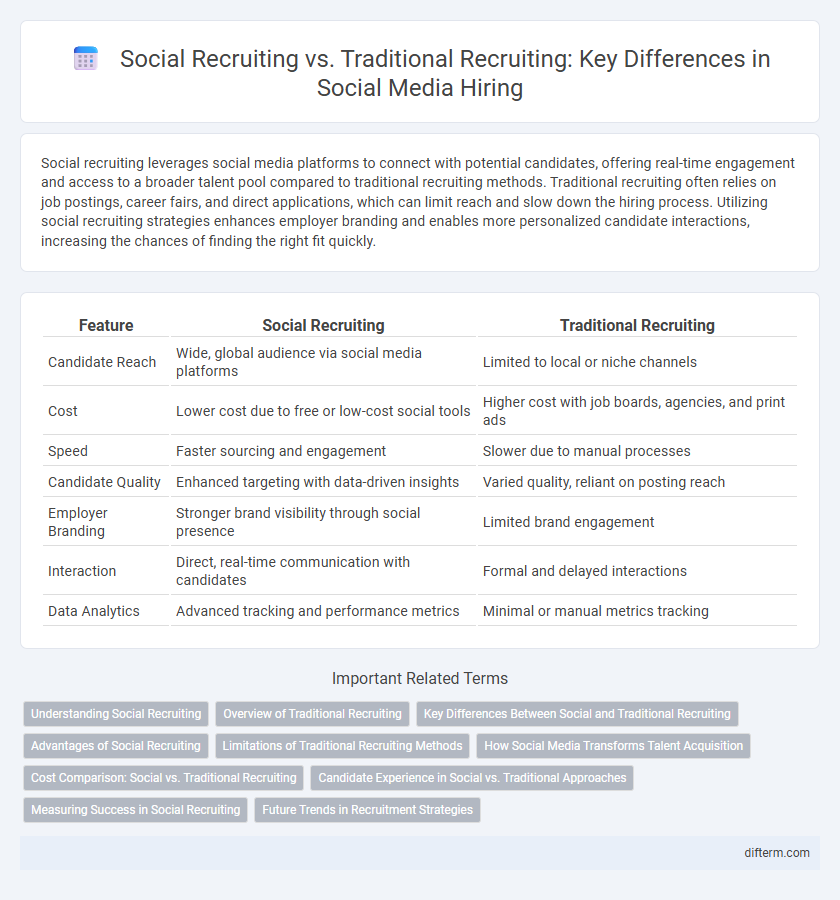Social recruiting leverages social media platforms to connect with potential candidates, offering real-time engagement and access to a broader talent pool compared to traditional recruiting methods. Traditional recruiting often relies on job postings, career fairs, and direct applications, which can limit reach and slow down the hiring process. Utilizing social recruiting strategies enhances employer branding and enables more personalized candidate interactions, increasing the chances of finding the right fit quickly.
Table of Comparison
| Feature | Social Recruiting | Traditional Recruiting |
|---|---|---|
| Candidate Reach | Wide, global audience via social media platforms | Limited to local or niche channels |
| Cost | Lower cost due to free or low-cost social tools | Higher cost with job boards, agencies, and print ads |
| Speed | Faster sourcing and engagement | Slower due to manual processes |
| Candidate Quality | Enhanced targeting with data-driven insights | Varied quality, reliant on posting reach |
| Employer Branding | Stronger brand visibility through social presence | Limited brand engagement |
| Interaction | Direct, real-time communication with candidates | Formal and delayed interactions |
| Data Analytics | Advanced tracking and performance metrics | Minimal or manual metrics tracking |
Understanding Social Recruiting
Social recruiting leverages digital platforms like LinkedIn, Facebook, and Twitter to identify and engage potential candidates through targeted content and peer networks. This method enables recruiters to tap into passive talent pools by utilizing social signals, employee referrals, and interactive branding strategies that traditional recruiting often overlooks. Employing data analytics and social algorithms improves candidate quality and accelerates the hiring process compared to conventional job postings and manual screening.
Overview of Traditional Recruiting
Traditional recruiting relies heavily on job postings, resume screenings, and in-person interviews to identify candidates. It often involves manual processes and extensive paperwork, which can extend the hiring timeline and limit talent pool diversity. This method typically depends on established networks and offline methods rather than leveraging digital platforms for broader reach.
Key Differences Between Social and Traditional Recruiting
Social recruiting leverages platforms like LinkedIn, Facebook, and Twitter to actively engage potential candidates through targeted advertising and networking, while traditional recruiting relies heavily on job boards, newspaper ads, and career fairs. Social recruiting provides real-time interaction, broader reach, and enhanced employer branding, contrasted with the slower, more passive nature of traditional methods. Data shows that social recruiting reduces time-to-hire by up to 30% and increases candidate quality through personalized engagement and social proof.
Advantages of Social Recruiting
Social recruiting leverages platforms such as LinkedIn, Facebook, and Instagram to access a broader and more diverse talent pool faster than traditional recruiting methods. It enhances employer branding by showcasing company culture and values through engaging content, attracting candidates who align with the organization's mission. Data-driven targeting and real-time interaction increase recruitment efficiency, reducing time-to-fill and cost-per-hire significantly compared to conventional recruitment processes.
Limitations of Traditional Recruiting Methods
Traditional recruiting methods often rely heavily on limited job boards and resumes, resulting in a narrow talent pool and slower hiring processes. These methods can struggle with reaching passive candidates and lack the dynamic engagement offered by social recruiting platforms. Consequently, they may lead to prolonged vacancies and higher recruitment costs due to inefficiencies in identifying and attracting qualified talent.
How Social Media Transforms Talent Acquisition
Social media revolutionizes talent acquisition by enabling recruiters to access a broader and more diverse candidate pool through platforms like LinkedIn, Twitter, and Facebook. The use of targeted social campaigns and real-time engagement accelerates the identification and attraction of passive candidates who are often missed by traditional recruiting methods. Enhanced employer branding on social channels increases candidate trust and application rates, optimizing recruitment efficiency and quality.
Cost Comparison: Social vs. Traditional Recruiting
Social recruiting significantly reduces costs by leveraging platforms like LinkedIn, Facebook, and Twitter to target candidates directly, eliminating expenses associated with job fairs, print advertising, and recruitment agencies. Traditional recruiting often involves high fees for job postings, agency commissions averaging 20-30% of first-year salary, and extensive administrative efforts leading to indirect costs. The ROI of social recruiting is enhanced by faster hire times and lower turnover rates due to better cultural fit through advanced candidate profiling and engagement tools.
Candidate Experience in Social vs. Traditional Approaches
Social recruiting enhances candidate experience by offering more personalized and immediate communication through platforms like LinkedIn and Facebook, accelerating feedback and engagement. Traditional recruiting often involves slower, less interactive processes that can lead to candidate frustration and disengagement. Leveraging social recruiting tools increases transparency and convenience, resulting in higher candidate satisfaction and improved talent acquisition outcomes.
Measuring Success in Social Recruiting
Social recruiting boosts candidate engagement by leveraging platforms like LinkedIn, Facebook, and Instagram, enabling precise tracking of application sources and conversion rates. Metrics such as time-to-hire, quality of hire, and candidate engagement rates demonstrate higher efficiency compared to traditional recruiting methods. Utilizing advanced analytics tools in social recruiting allows recruiters to optimize strategies based on real-time data, ultimately improving recruitment ROI.
Future Trends in Recruitment Strategies
Social recruiting leverages advanced AI algorithms and mobile platforms to enhance candidate engagement and streamline talent acquisition processes. Future recruitment strategies prioritize personalized candidate experiences using data analytics and social media insights to identify passive talent more effectively. Traditional recruiting methods are increasingly supplemented by virtual reality assessments and automated chatbots, enabling faster, scalable, and more inclusive hiring practices.
social recruiting vs traditional recruiting Infographic

 difterm.com
difterm.com